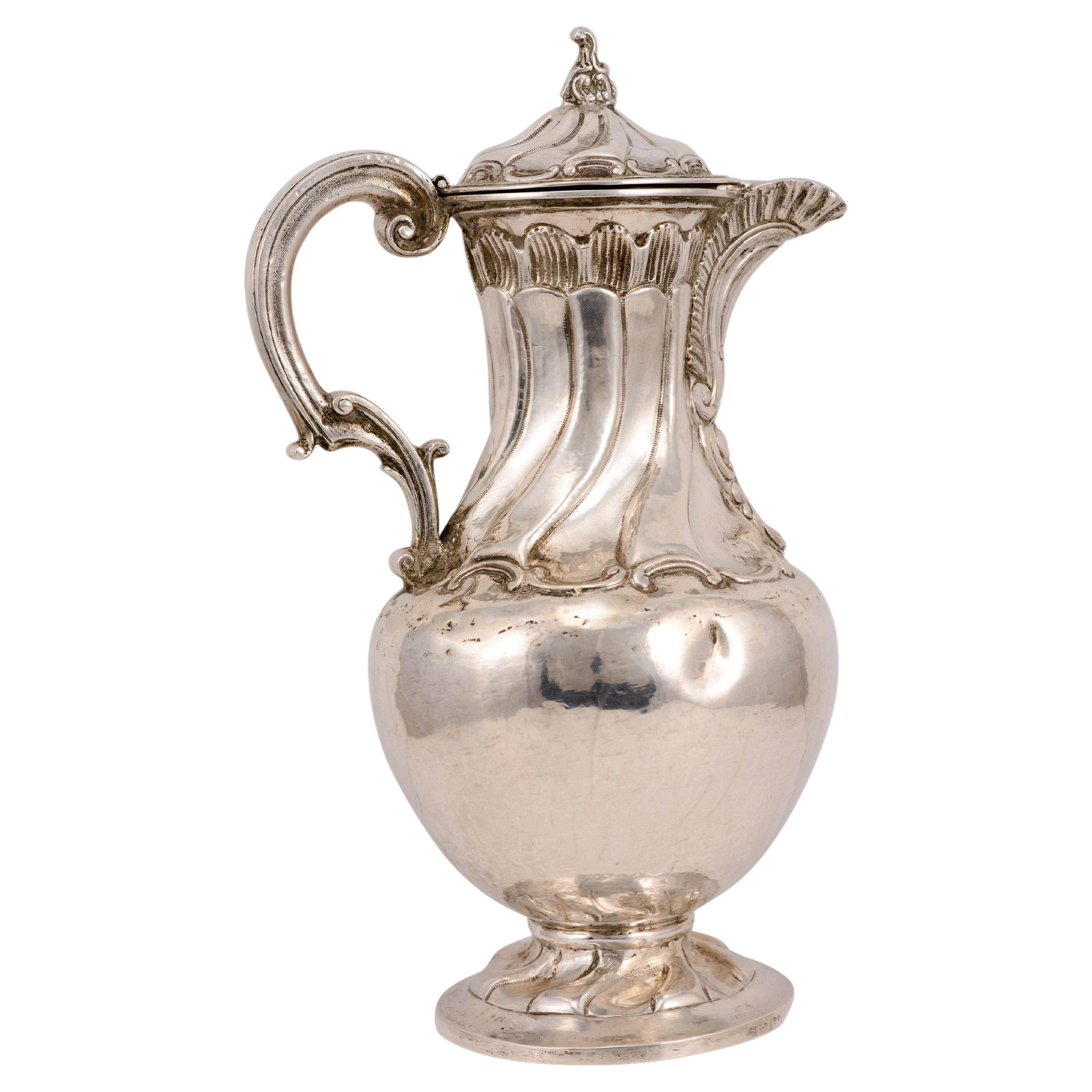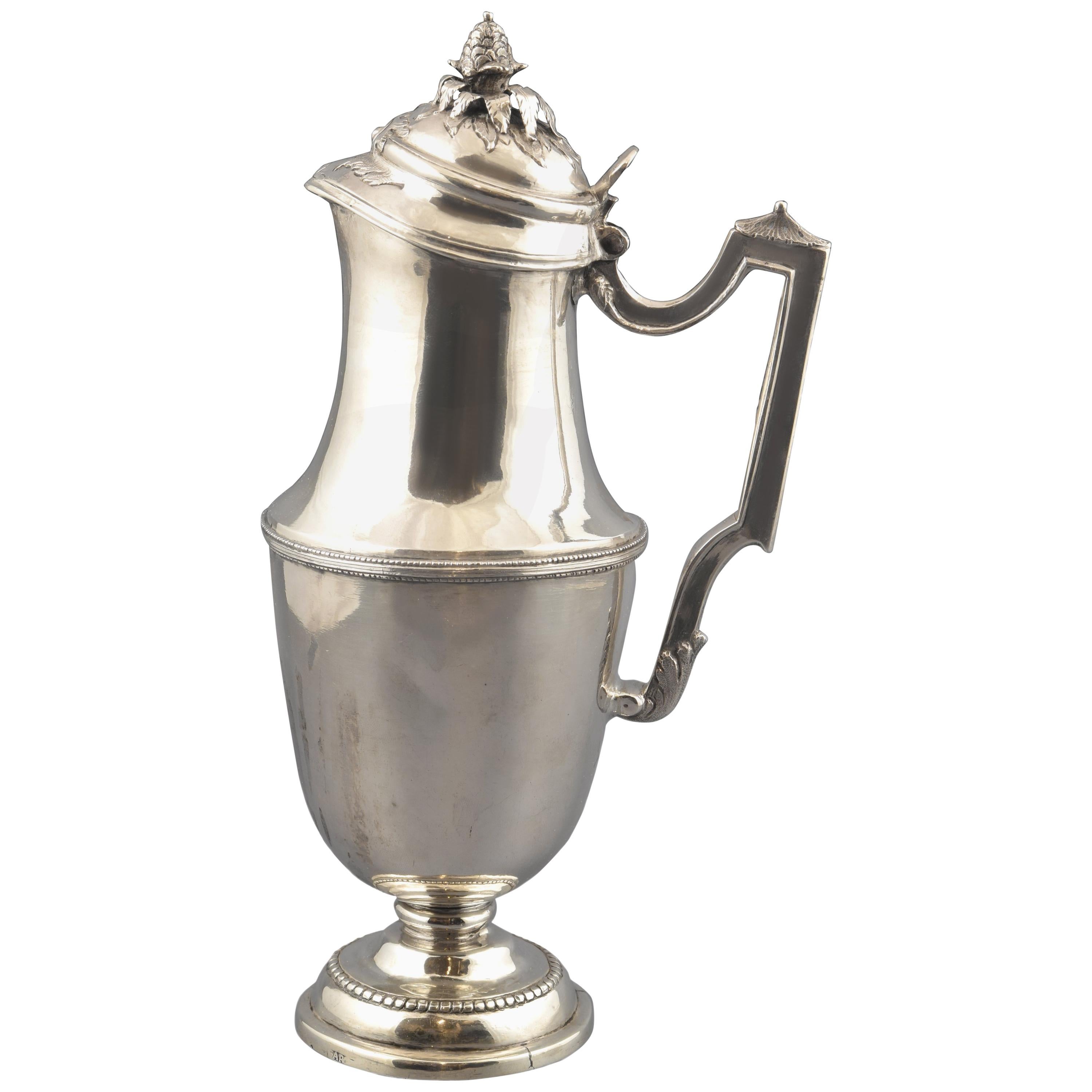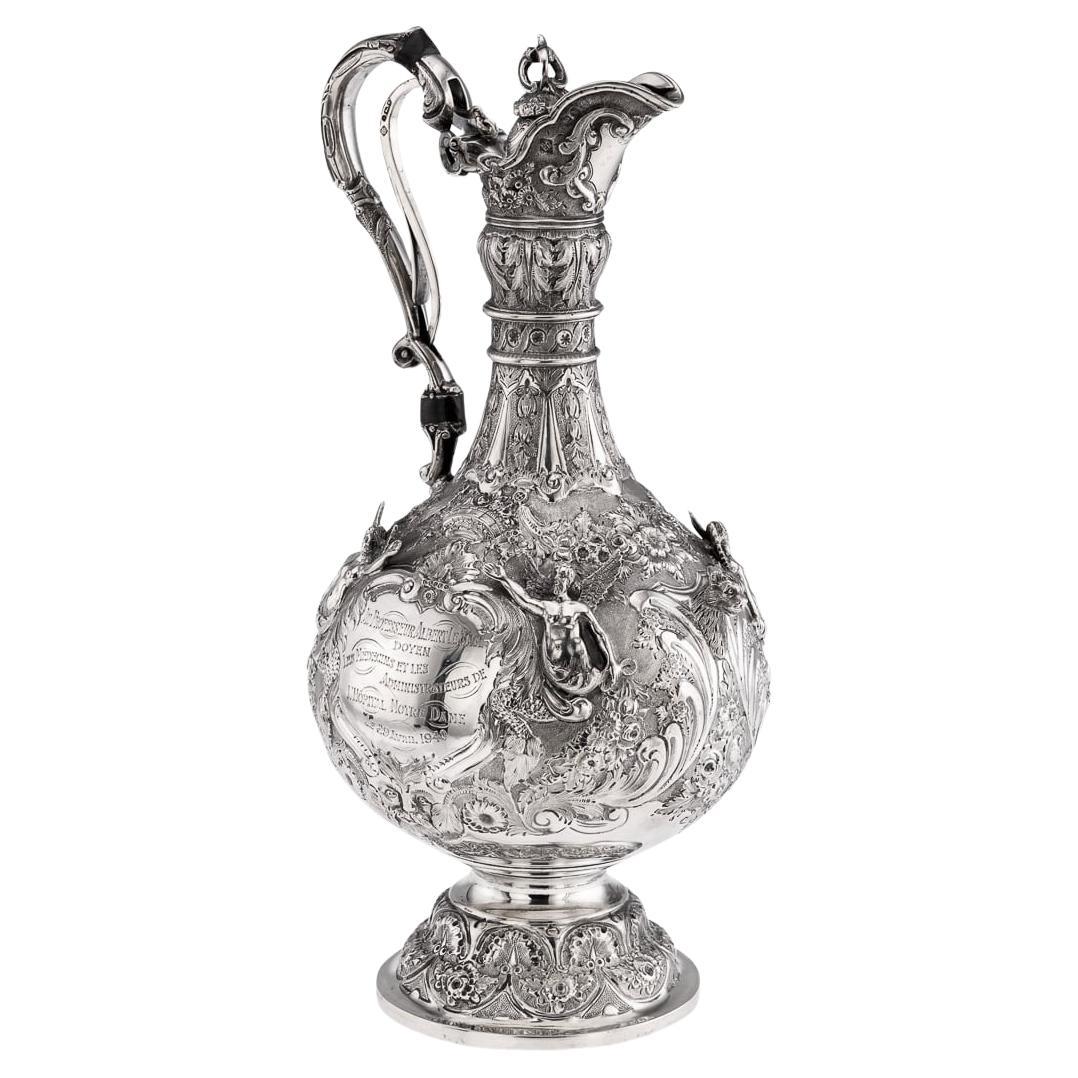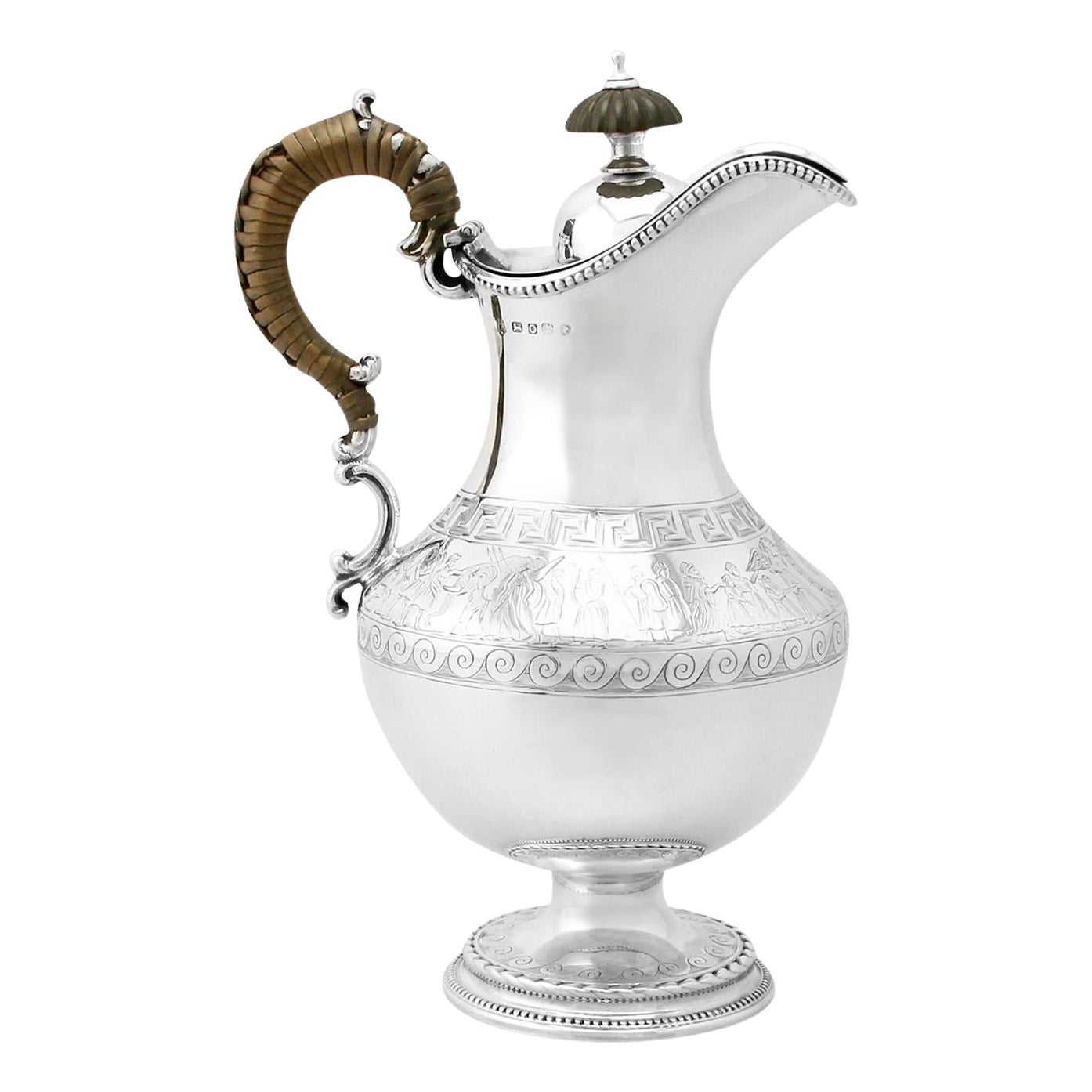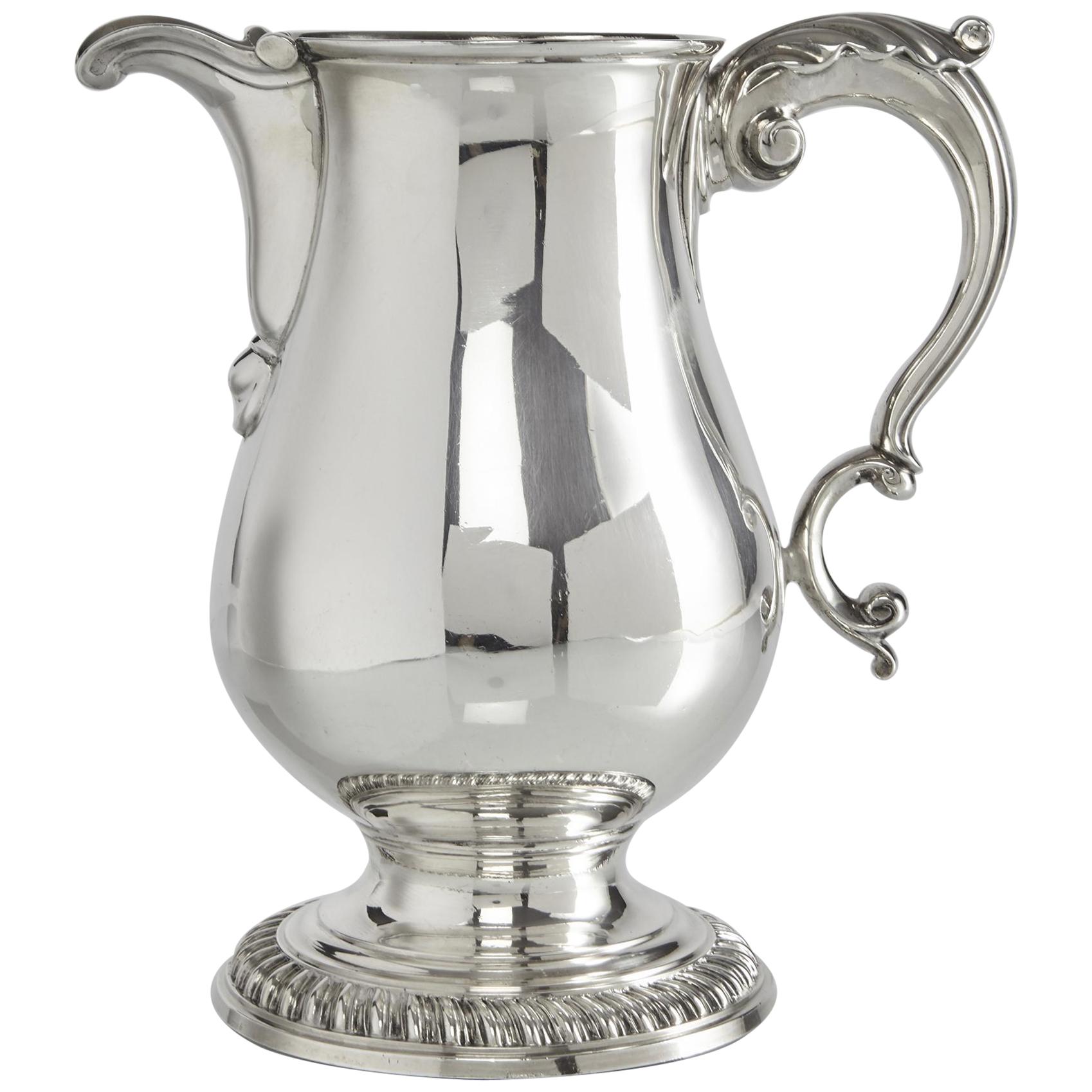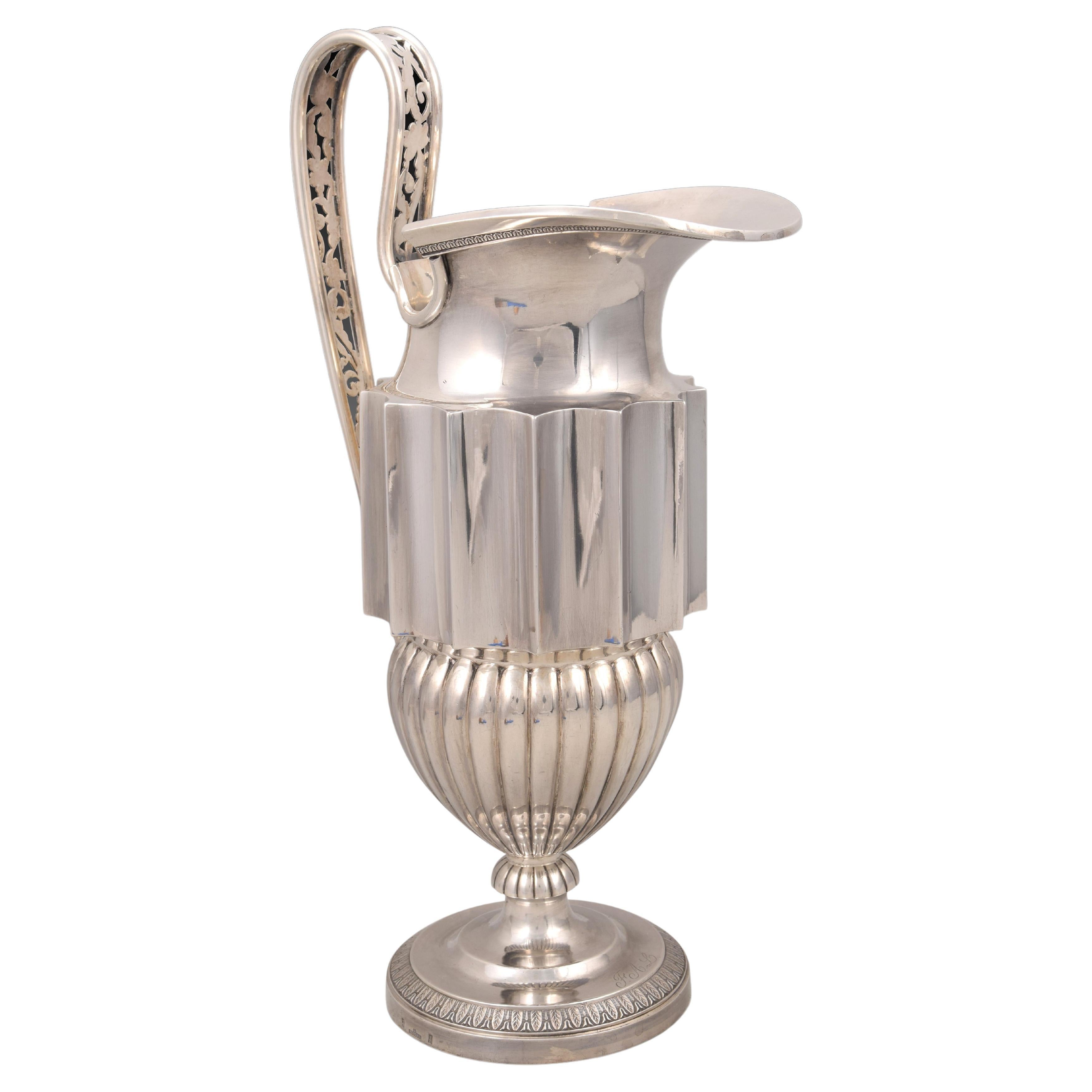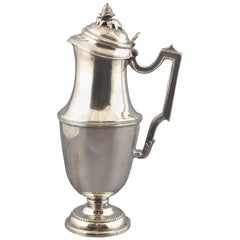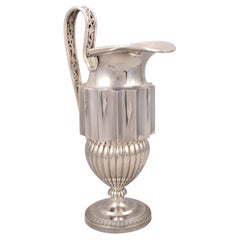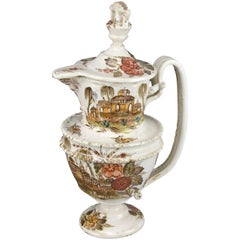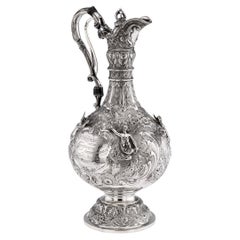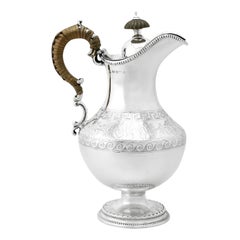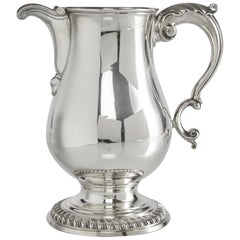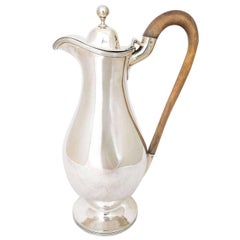Items Similar to Silver jar or jug. MARTINEZ MORENO, Mateo. Cordoba, Spain, possibly 1797.
Want more images or videos?
Request additional images or videos from the seller
1 of 15
Silver jar or jug. MARTINEZ MORENO, Mateo. Cordoba, Spain, possibly 1797.
$4,302.30
£3,185
€3,600
CA$5,953.31
A$6,562.38
CHF 3,433.75
MX$80,518.40
NOK 43,224.13
SEK 40,421.40
DKK 27,410.38
About the Item
Jug or jug. Silver in its color. MARTINEZ MORENO, Mateo. Cordoba, Spain, possibly 1797.
With contrast and chisel marks.
Made in silver in its color, the jug has an oval base, which rises flat until it reaches a molding with vertical lines grouped three by three; after it, it presents a curve and a decoration of engraved circles until it reaches the body of the piece. This is divided into three areas, a widening below until reaching the central area and, finally, another curve to the mouth, all decorated with a series of curved "gajos" of different widths. The handle, of a type known as a brace, presents architectural and plant decorations. The lid repeats the lines of the body and ends with a vegetable shape, in addition to presenting a piece towards the handle. The peak, curved towards the outside, shows two moldings halfway down. The typology to which this jug belongs was common in Spanish silverware during the Rococo, being able to find models similar to the present both in the capital and in other centers. With Felipe V, numerous French influences came to silverware, along with some Italian ones, both at the hands of craftsmen of these origins and pieces. It continues with a scarce marking in the works except in important centers such as Madrid, and civil typologies acquired great importance. As in the rest of the country, the Baroque, Rococo and Neoclassical tendencies coexisted at the Court, although, being the center that set the tone for the rest, the former soon departed, introducing the Rococo before 1740 or on that date, and Neoclassicism around 1770 (gradually imposing itself from 1780). Let us remember, once again, that the jug follows the most common prototype since the arrival of the Bourbons, characterized by its European influence and by the great difference it shows with the type known as "spout jug" (present in the Renaissance, etc. ). It presents several contrasting marks in different points of the piece, some frustras (partially preserved). It is possible to identify the name of the town, Córdoba, and that of the master silversmith, missing the complete identification of the numbering alluding to the date of creation of the work. Mateo Martínez Moreno was active in Córdoba during approximately the second half of the 18th century and was a faithful contrast to the same city between 1780 and 1804 (the year in which he died).
Weight: 1,167 kg. · Size: 19x11x29 cms
International Buyers – Please Note: for those articles that need Export Permits (those older than 100 years), the obtaining of the Permit will be processed without additional expenses (if you choose the seller sends it to you), but the period for the obtention of it may vary from 10 to 35 days.
- Creator:Mateo Martínez Moreno (Artist)
- Dimensions:Height: 11.42 in (29 cm)Width: 7.49 in (19 cm)Depth: 4.34 in (11 cm)
- Style:Rococo (Of the Period)
- Materials and Techniques:
- Place of Origin:
- Period:
- Date of Manufacture:Possibly 1797
- Condition:Wear consistent with age and use. Minor losses. Minor fading.
- Seller Location:Madrid, ES
- Reference Number:Seller: zf11041stDibs: LU2951334908342
About the Seller
4.9
Vetted Professional Seller
Every seller passes strict standards for authenticity and reliability
Established in 1985
1stDibs seller since 2017
350 sales on 1stDibs
Typical response time: 17 hours
- ShippingRetrieving quote...Shipping from: MADRID, Spain
- Return Policy
Authenticity Guarantee
In the unlikely event there’s an issue with an item’s authenticity, contact us within 1 year for a full refund. DetailsMoney-Back Guarantee
If your item is not as described, is damaged in transit, or does not arrive, contact us within 7 days for a full refund. Details24-Hour Cancellation
You have a 24-hour grace period in which to reconsider your purchase, with no questions asked.Vetted Professional Sellers
Our world-class sellers must adhere to strict standards for service and quality, maintaining the integrity of our listings.Price-Match Guarantee
If you find that a seller listed the same item for a lower price elsewhere, we’ll match it.Trusted Global Delivery
Our best-in-class carrier network provides specialized shipping options worldwide, including custom delivery.More From This Seller
View AllJug. Silver. Santacruz Zaldúa, Antonio. Cordoba (Spain). 18th century.
Located in Madrid, ES
Jug. Silver. Santacruz Zaldúa, Antonio. Cordoba (Spain). 18th century.
With contrast marks.
A silver vase in its original color, featuring a circular base decorated with spiral se...
Category
Antique 18th Century Spanish Baroque Sterling Silver
Materials
Silver
Silver Jug with Illegible Hallmarks, 18th Century
Located in Madrid, ES
Jug with lid and silver handle in its color that has a circular foot decorated and raised with a series of moldings and a band of pearls, from which part a small foot that gives way ...
Category
Antique 18th Century European Rococo Serving Pieces
Materials
Silver
Jug or Jar, Silver, Sellan, Juan. Madrid, 1847
By Juan Sellán
Located in Madrid, ES
Jug. Silver. SELLAN, Juan. Madrid, 1847.
With contrast markings.
Silver pitcher in its color that has a flat handle decorated with simple openwork plant elements between two smoo...
Category
Antique 1840s Spanish Neoclassical Serving Pieces
Materials
Silver
Villafeliche Jug, Aragon, Spain, 18th Century
Located in Madrid, ES
Late Baroque pottery jug made and decorated with high temperature glazes over a white slip of tin. These motifs are combined with enameled decorations in relief obtained mold. The typology of the piece combines Italian jug with handle ovoid belly and vertical bow, with the peak jug typically Spanish, characterized by the outgoing peak of the mouth. Decorations reveal the oriental influence, with large floral bouquets arranged asymmetrically and complex landscapes with architecture and palm trees, which remove some figures, such as totally Western. The reasons appear pincelados in manganese black, and colored with ocher, blue, green and red, mainly enamels. Aragon ceramic least a century old will be characterized by a strong own, combined with the influences of personality Talavera and Catalonia. You will have three main centers: Teruel, Muel and Villafeliche, the first two with tradition since the 16th century, and the third created in the late 17th century. The Villafeliche will generally be very popular ceramics...
Category
Antique 18th Century Spanish Neoclassical Ceramics
Materials
Ceramic
Claret Jug, Silver, Anselmo Prior and Mason, Vitoria, Spain, 1816-1846
Located in Madrid, ES
Jug. Silver. Anselm Prior and Mason. Vitoria, Spain, between 1816 and 1846.
With contrast markings.
Silver jug in its color with a square base that serves as a support for the ci...
Category
Antique 19th Century Spanish Neoclassical Jars
Materials
Silver, Other
Jug. Glass, silver metal. Possibly WMF, Germany. Around 1900.
Located in Madrid, ES
Jug. Glass, silver metal. Possibly WMF, Germany. Around 1900.
With contrast markings (handle).
Jug with a transparent glass body decorated with geometric elements, a circular base,...
Category
Early 20th Century European Other Pitchers
Materials
Metal
You May Also Like
Antique 19th Century Victorian Solid Silver Armada Jug, London c.1891
By Martin Hall & Co.
Located in Royal Tunbridge Wells, Kent
Antique 19th Century Victorian solid silver "Armada" pattern jug, with scroll handle, the hinged lid has an ornate finial and opens squeezing the handle trigger, baluster body, domed...
Category
Antique 19th Century British Other Sterling Silver
Materials
Silver
Victorian Sterling Silver Hot Water Jug
By Henry Wilkinson & Co.
Located in Jesmond, Newcastle Upon Tyne
A fine and impressive antique Victorian English sterling silver wine or water jug, an addition to our antique silverware collection.
This impressive Victorian sterling silver hot water...
Category
Antique 1850s English Victorian Sterling Silver
Materials
Silver, Sterling Silver
George III Silver Beer or Water Jug
Located in London, GB
In excellent and original condition, this is a Classic, heavy-gauge antique George III silver beer jug in a design that personifies the style of the period...
Category
Antique 1760s English George III Pitchers
Materials
Sterling Silver
Sterling Silver Jug
By Charles Stuart Harris
Located in London, GB
This beautiful and elegant English silver jug was made by the eminent London silver firm of Charles Stuart Harris in 1890.
The style is neoclassical and t...
Category
Antique 19th Century British Neoclassical Sterling Silver
Materials
Silver
$2,411
1760s Sterling Silver Beer / Water Jug
Located in Jesmond, Newcastle Upon Tyne
A magnificent, fine and impressive antique George III English sterling silver beer/water jug; part of our dining silverware collection.
This magnificent a...
Category
Antique 1760s English George III Sterling Silver
Materials
Sterling Silver, Silver
Antique English Sterling Silver Victorian Wine Ewer Claret Jug Walker Hall 1892
By John Edward Bingham (Walker and Hall)
Located in Dublin, Ireland
An Exquisite English Regency Style Victorian Sterling Silver Heavy Gauge Table Wine Jug Ewer of traditional outline.
The vine leaf body decoration below a hinged cover with an attr...
Category
Early 20th Century Irish Rococo Sterling Silver
Materials
Sterling Silver
More Ways To Browse
Oval Room Divider
French Silverware
Spanish Jugs
Antique Pitcher And Bowl
Glass Pitcher With Lid
Silver And Glass Coffee Carafe
Antique Tin Pitcher
Japanese Jug
Medieval Jug
Silver Gilt Ewer
Smoke Rings
Tiffany And Co Sterling Silver Pitcher
Antique Claret Decanter
Blue Pottery Jug
Pitcher And Basin
19th Century Earthenware Pitchers
Minton Jug
Vintage Green Glass Jugs
